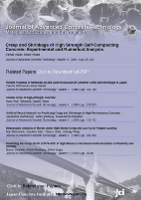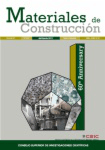
Journal of Advanced Concrete Technology
Scope & Guideline
Shaping the Future of Construction with Concrete Insights
Introduction
Aims and Scopes
- Concrete Durability and Performance:
Research focusing on the long-term behavior of concrete under various environmental conditions, including exposure to chemicals, freeze-thaw cycles, and corrosion mechanisms. - Sustainable Concrete Practices:
Exploration of alternative materials and methods for enhancing sustainability in concrete production, including the use of supplementary cementitious materials (SCMs) and recycling of industrial by-products. - Innovative Concrete Materials:
Development and characterization of new concrete formulations, such as geopolymer and fiber-reinforced concretes, aimed at improving mechanical properties and performance. - Numerical Modeling and Simulation:
Utilization of computational methods to predict the behavior of concrete structures, analyze stress distribution, and assess the impact of various factors on concrete performance. - Experimental Investigations:
Empirical studies examining the physical and chemical properties of concrete, including hydration processes, mechanical testing, and the effects of admixtures. - Structural Applications and Design:
Research on the design, analysis, and performance of concrete structures, including reinforced concrete, precast elements, and composite systems.
Trending and Emerging
- Alkali-Activated Materials and Geopolymers:
Increased interest in alkali-activated materials and geopolymer concrete formulations as sustainable alternatives to traditional Portland cement has emerged, driven by environmental concerns. - Nanotechnology in Concrete:
Research exploring the incorporation of nanomaterials, such as nano-silica and nano-alumina, to enhance the mechanical properties and durability of concrete has gained traction. - Self-Healing Concrete Technologies:
Innovations in self-healing mechanisms for concrete, including the use of bacterial agents and encapsulated healing agents, are becoming a significant focus area. - Advanced Characterization Techniques:
The use of advanced imaging and characterization methods, such as X-ray computed tomography and molecular dynamics simulations, to study concrete at micro and nano scales is on the rise. - Performance Under Extreme Conditions:
Research examining the behavior of concrete under extreme conditions, such as high temperatures, radiation exposure, and aggressive chemical environments, is increasingly relevant.
Declining or Waning
- Traditional Concrete Mix Designs:
Research on conventional concrete mix designs and formulations has seen a decline as interest shifts towards advanced materials and sustainable practices. - Basic Mechanical Properties of Conventional Concrete:
Studies centered solely on the basic mechanical properties of standard concrete have become less prevalent, with more emphasis now placed on innovative materials and complex behaviors. - Long-term Studies of Conventional Concrete:
Longitudinal studies examining the performance of traditional concrete under typical conditions are less common, as researchers pursue more complex interactions and advanced materials. - Basic Reinforcement Techniques:
Research focusing on basic reinforcement methods, such as traditional steel rebar applications, has waned in favor of advanced composites and hybrid systems that enhance performance.
Similar Journals

International Journal of Concrete Structures and Materials
Championing Open Access to Concrete Research ExcellenceThe International Journal of Concrete Structures and Materials, published by SPRINGER, is a premier open-access journal dedicated to the field of civil and structural engineering, with a strong emphasis on concrete materials and their diverse applications. With an ISSN of 1976-0485 and E-ISSN of 2234-1315, this journal has established itself as a crucial resource since its inception in 2012, addressing pressing challenges in structural integrity and durability. With a remarkable impact factor and ranking in the Q1 category for both Civil and Structural Engineering and Ocean Engineering, this journal has garnered recognition and respect, ranking #18 out of 105 in Ocean Engineering and #81 out of 379 in Civil and Structural Engineering as per Scopus metrics. The journal’s open-access policy enhances the dissemination of knowledge, making cutting-edge research readily available to a global audience. Aimed at researchers, practitioners, and students alike, the International Journal of Concrete Structures and Materials strives to promote advancements in concrete technology and foster innovative solutions for contemporary engineering problems.

R Journal
Innovating Methodologies for Tomorrow's Data ChallengesR Journal, published by the R Foundation for Statistical Computing, is a premier academic journal dedicated to advancing the fields of numerical analysis and statistical methodologies. With an ISSN of 2073-4859, the journal has established itself as a significant platform for high-quality research since its inception in 2009. It operates under a Q2 category ranking in respective fields, including Statistics and Probability, among others, highlighting its influence and relevance in the academic community. Researchers are encouraged to contribute their findings, as the journal appeals broadly to statisticians, mathematicians, and data scientists alike. Although not an open-access journal, its commitment to rigorous peer review ensures that published works maintain high standards of scientific integrity. The R Journal's vision is to foster innovative approaches within statistical computing, making it an invaluable resource for those seeking to deepen their understanding or stay abreast of developments in the discipline.

Journal of Materials and Engineering Structures
Transforming Ideas into Engineering ExcellenceJournal of Materials and Engineering Structures is a pioneering Open Access journal published by MOULOUD MAMMERI UNIVERSITY OF TIZI-OUZOU, dedicated to advancing the field of materials science and engineering. Since its inception in 2014, the journal has aimed to provide researchers, professionals, and students with a platform for sharing cutting-edge research and innovative applications in materials engineering and construction structures. Although the HIndex and Scopus ranking data are not specified, the journal plays a crucial role in disseminating knowledge that contributes to the development of sustainable and efficient engineering practices. With its commitment to accessibility and knowledge sharing in the heart of Algeria, the Journal of Materials and Engineering Structures is poised to make a significant impact on both local and global academic communities.

Frontiers of Structural and Civil Engineering
Elevating Standards in Structural and Civil EngineeringFrontiers of Structural and Civil Engineering, published by HIGHER EDUCATION PRESS, is a premier academic journal dedicated to advancing the fields of architecture, civil, and structural engineering. With an ISSN of 2095-2430 and E-ISSN of 2095-2449, this journal caters to the dissemination of high-quality research and innovative practices from 2012 onwards, highlighting important developments up until 2024. Ranked in the top quartile (Q1) for Architecture and Q2 for Civil and Structural Engineering in 2023, it holds an impressive Scopus ranking of #19 out of 189 in Architecture and #101 out of 379 in Civil and Structural Engineering, reflecting its impact and relevance in the scientific community. This journal invites contributions that demonstrate pioneering approaches, fostering collaboration among researchers, professionals, and students alike, and significantly contributes to the global knowledge base in the engineering disciplines.

Archives of Civil and Mechanical Engineering
Driving Impactful Discoveries in EngineeringArchives of Civil and Mechanical Engineering is a distinguished peer-reviewed journal published by SpringerNature, focusing on advancing the fields of civil and mechanical engineering. With an impressive Q1 ranking in both categories in 2023, this journal caters to a global audience, addressing the evolving challenges and innovations within these vital engineering disciplines. The journal has been a pivotal platform since its inception in 2006, and it continues to be essential for researchers and practitioners seeking to publish and access high-quality research. The absence of an Open Access option ensures that published works maintain rigorous academic standards, thereby enhancing their value within institutional repositories. With a robust impact factor and high visibility on Scopus—ranking #122 out of 672 in Mechanical Engineering and #74 out of 379 in Civil and Structural Engineering—this journal is an ideal venue for professionals, researchers, and students dedicated to advancing their knowledge and contributing to cutting-edge engineering practices. Based in Germany and operating internationally, the Archives of Civil and Mechanical Engineering invites submissions that address critical issues and solutions in contemporary engineering.

MATERIALES DE CONSTRUCCION
Unveiling the Potential of Building MaterialsMATERIALES DE CONSTRUCCION is a leading international journal dedicated to the fields of Building and Construction, Materials Science, and Mechanics of Materials, published by the CONSEJO SUPERIOR INVESTIGACIONES CIENTIFICAS-CSIC in Spain. With a rich history dating back to 1957 as an Open Access journal, it provides an invaluable platform for disseminating research findings that advance the science and application of materials in construction and engineering. The journal, indexed in Scopus, maintains a Q2 ranking in esteemed categories such as Building and Construction, and demonstrates significant impact with its ranking placements, including #91 in Building and Construction and #197 in Mechanics of Materials. Aimed at researchers, professionals, and students, MATERIALES DE CONSTRUCCION is committed to publishing high-quality studies that reflect the latest advancements in the discipline, fostering innovation and collaboration within the scientific community. For its readers, the journal offers a wealth of knowledge accessible from anywhere, ensuring that vital research is shared and utilized across the globe.

Hormigon y Acero
Pioneering Research in Structural IntegrityHormigon y Acero, an esteemed journal published by the ASOC ESPANOLA INGENIERIA ESTRUCTURAL-ACHE, serves as a vital resource in the fields of structural engineering and construction. With an ISSN of 0439-5689 and an E-ISSN of 2605-1729, this journal plays a critical role in disseminating innovative research and advancements from 2019 to 2024, particularly focusing on concrete and steel applications. Although it does not currently offer open access, its contributions remain invaluable to professionals and academics seeking to enhance their understanding and practices in engineering disciplines. Ranked within the 13th percentile in Building and Construction and the 9th percentile in Civil and Structural Engineering according to Scopus, Hormigon y Acero is recognized for its rigorous peer-reviewed content that addresses contemporary challenges and innovations within the industry. The journal is positioned in Madrid, Spain, and aims to foster collaboration and knowledge exchange among researchers, practitioners, and students dedicated to the advancement of structural engineering.

Materia-Rio de Janeiro
Fostering collaboration for impactful scientific discoveries.Materia-Rio de Janeiro is a distinguished open-access journal published by UNIV FED RIO DE JANEIRO, LAB HIDROGENIO, dedicated to advancing knowledge in the fields of Chemistry, Materials Science, and Physics. Since its inception in 2006, the journal has established a platform for the dissemination of innovative research, fostering collaboration among researchers globally. The journal's commitment to open access promotes the widespread availability of valuable scientific findings, making it an essential resource for academia and industry professionals alike. With a focus on diverse disciplines, Materia-Rio de Janeiro holds a Q4 classification in multiple categories for 2023, indicating its relevance in the expansive landscape of materials research. Operating from Rio de Janeiro, Brazil, this journal serves as a vital conduit for emerging scientific insights, hence delivering impactful contributions to the global research community.

Computers and Concrete
Fostering Collaboration in Concrete and Computational InnovationsComputers and Concrete is a leading academic journal published by TECHNO-PRESS, focusing on the interdisciplinary field of computational mechanics as applied to civil engineering and concrete materials. With an impressive impact factor consistent with its status in its category, this journal holds a prestigious Q1 ranking in Computational Mechanics for 2023, being recognized as one of the top journals within this domain. Since its inception in 2006, Computers and Concrete has provided a vital platform for researchers and professionals to disseminate innovative findings, fostering collaboration and knowledge exchange among an engaged community. The journal is available in both print and digital formats, ensuring accessibility to a wide audience of academics and practitioners alike. By featuring high-quality research articles, review papers, and technical notes, this journal plays a crucial role in advancing the understanding and application of computational techniques in the field of concrete and structural engineering.

Structural Concrete
Leading the Way in Concrete Material InnovationsStructural Concrete, published by ERNST & SOHN, is a premier journal dedicated to the field of Civil and Structural Engineering, focusing on innovative research and advancements in concrete materials and technologies. With an impressive impact factor and a consistent ranking in the Q1 category of both Building and Construction and Civil and Structural Engineering, the journal stands as a vital resource for researchers, professionals, and students alike. It is indexed with notable Scopus ranks, underscoring its significance within the academic community. The journal spans a comprehensive scope (from 2001 to the present) that encompasses diverse topics related to the behavior, design, and application of structural concrete. Although not an open access publication, it offers valuable insights and cutting-edge knowledge that contribute to the ongoing evolution of construction practices and materials science. Structural Concrete is an essential platform for sharing pioneering findings and fostering collaboration within this dynamic field.